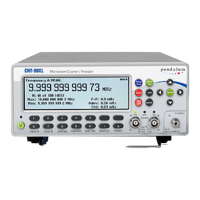■ CNT-90XL: Microwave Conversion
As mentioned before, a prescaler in the
C-in-put divides the input frequency before it is
counted by the normal digital counting logic.
The division factor is called prescaler factor
and can have different values depending on the
prescaler type. The 3 GHz prescaler is designed
for a prescaling factor of 16. This means that an
input C frequency of, e.g., 1.024 GHz is
transformed to 64 MHz.
Prescalers are designed for optimum perfor-
m
ance when measuring stable continuous RF.
M
ost prescalers are inherently unstable and
would self-oscillate without an input signal. To
prevent a prescaler from oscillating, a
"go-detector" is incorporated. See Fig. 4-13.
The go-detector continuously measures the
level of the input signal and simply blocks the
prescaler output when no signal, or a signal that
is too weak, is present.
Go-detector in the prescaler.
The presence of a burst signal to be measured
makes certain demands upon the signal itself.
Regardless of the basic counter's ability to
measure during very short measurement times,
the burst duration must meet the following
minimum conditions:
Burst
min
> (presc. factor) x (inp. cycle time) x 3
or at least 80 ns
Normally the real minimum limit is set by other
factors, like the speed of the GO-detector. This
speed depends on the specific input option
used.
Measuring frequencies up to 20 GHz is possi-
ble with the top-performance prescaler option
14B. The general principles of prescalers are
described in the preceding paragraph.
The different versions of the CNT-90XL are
intended for applications with upper frequency
limits between 27 GHz and 60 GHz.
Here another technique is utilized, down
conversion by means of mixing the unknown
signal with known LO frequencies until there
is a signal present within the passband of the
IF amplifier, in this case 10 - 200 MHz.
A simplified block diagram can be seen in Fig.
4-14.
Microwave acquisition in the
CNT-90XL.
The basic LO frequency range is 430 - 550
MHz and is divided into a number of discrete
frequencies fetched from a look-up table. The
LO output is fed to a comb generator that cre-
ates a harmonic spectrum covering the whole
specified microwave range.
The automatic process of calculating the input
frequency consists of the
following steps:
USER MANUAL ● CNT 9x Series ● Rev.22 February 2020
4-12

